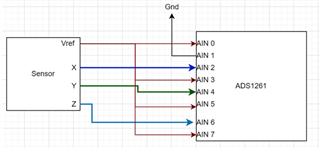Hi Bryan,
Need your inputs in configuring the ADC external reference and INPMUX configuration.
we had a sensor connected to ADS1261 as shown below (you may be knowing from the earlier conversations)

Here Vref is 2.5V and X,Y and Z are outputs(range is 0 to 4V). AIN0 and AIN1 are configured for external reference, AIN2-AIN3 for measuring X, AIN4-AIN5 for measuring Y and AIN6-AIN7 for measuring Z.
Below are my questions.
1) In place of AIN1, we would like to set AVSS internal (default) in negative input of REF register, so that AIN1 line can be eliminated. does AIN0-AVSS internal (default) configuration will work as external reference?
2) we want to use common negative input configuration in INPMUX register for measuring X, Y and Z. That means AIN2-AIN0 for measuring X, AIN4-AIN0 for measuring Y and AIN6-AIN0 for measuring Z. This will eliminate AIN3, AIN5, AIN7 lines. Which is better? having common negative input vs separate negative inputs. Doing this will have any effect in ADC counts of X, Y and Z?
Please advise.
Thank you,
Ram.

